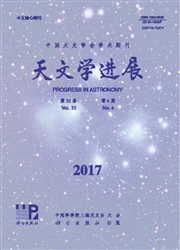

 中文摘要:
中文摘要:
自1979年以来,越来越多的观测证据表明,在许多盘状星系中普遍存在厚盘成分,它们在结构、化学组成和运动学等方面与薄盘有着明显的不同。一般而言,星系中厚盘的标高比薄盘大得多,厚盘恒星与薄盘恒星相比,金属丰度较低而年龄较老,绕星系中心的转动速度较慢而速度弥散度较大。上述观测证据表明厚盘确实是星系长期演化后的产物,对于研究河外星系的形成和演化史有着重要的天体物理意义。该文在简单回顾银河系和河外星系中厚盘发现和确认史的基础上,介绍了对星系厚盘结构参数等性质的探测途径和目前取得的一些主要认识,并与薄盘恒星的相应特征作了比较。结构参数主要包括厚盘和薄盘的标长、标高和轴比,其他观测性质有两类盘的颜色、年龄、金属度和运动学特性等。最后,结合上述观测性质,对厚盘形成的几种可能的机制及未来可以开展的工作做了简要的说明和讨论。
 英文摘要:
英文摘要:
Since thick disks in SO galaxies were originally detected in 1979, thick-disk components have been discovered in many disk galaxies, and there are more and more observational evidences that the thick disk in an external galaxy should be a component of the galaxy which is structurally, chemically and kinematically distinct from the thin disk of the galaxy. Generally speaking, for a galaxy the thick disk has its scale height significantly larger than the thin disk. Thick-disk stars are more metal-poor and older than stars in the thin disk and have both a slower rotation around the galaxy center and a larger velocity dispersion. It can be concluded from all these observational facts that thick disks are a kind of relic, which can be used to trace the formation and evolutional history of external galaxies. Edge-on disk galaxies have been extensively used by different authors to measure structural parameters and other observational properties of thin and thick disks. It is found from some recent studies that thick-disk scale heights are generally 2-6 times larger than thin-disk scale heights and the thick-disk scale lengths are slightly larger, which agree with what observed in the Milky Way Galaxy. The axial ratios of thick disks are normally in a range of 3:1-4:1, and those of thin disks can be over 8:1 in some galaxies. The ages of stars in thick disk are estimated to be 5-13 Ga, and their colors are significantly redder than thin-disk stars. Thick-disk stars are metal-poor with median metallicity of [Fe/H]--1 in some low mass galaxies and show no evidence for the strong vertical matallicity gradients. It has been found that the contribution of the thick disk to the total luminosity shows an obvious trend with mass. For high-mass galaxies (Vc 〉 120 km · s^-1), thick disks can contribute 10% of the total luminosity of the galaxy and for lower mass systems this value can be up to 40%. The analysis of vertical color gradients for some galaxies suggests that the color of thick disks are fairly uniform
 同期刊论文项目
同期刊论文项目
 同项目期刊论文
同项目期刊论文
 JET POWER EXTRACTED FROM ADAF AND THE APPLICATIONS TO X-RAY BINARIES AND THE RADIO GALAXY FR DICHOTO
JET POWER EXTRACTED FROM ADAF AND THE APPLICATIONS TO X-RAY BINARIES AND THE RADIO GALAXY FR DICHOTO 期刊信息
期刊信息
